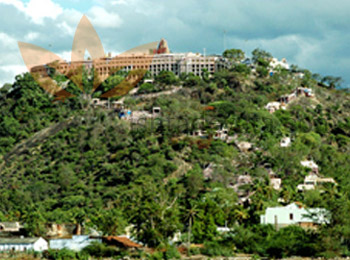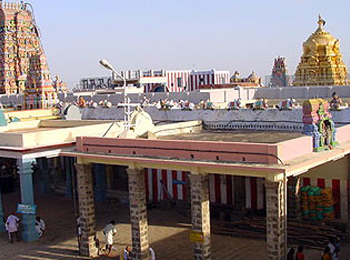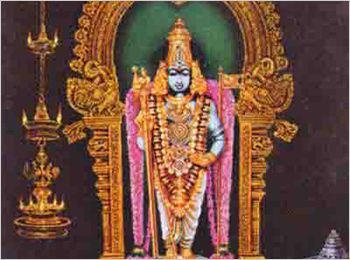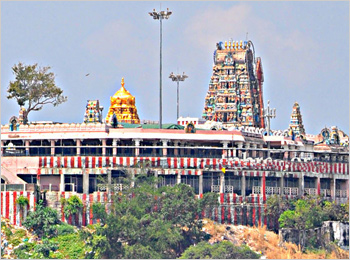- Murugan
Palani Murugan Temple
- Palani,Tamil Nadu
- View on map
- Tell us about this temple
Overview
The Palani Dhandayuthapani Temple, one of the six abodes of Lord Muruga is located in the Palani Hills, Dindigul, about 100 kms to the Southeast of Coimbatore and to the Northwest of Madurai, In Palani the lord wears a loin and has a staff in his grasp. This is at the highest point on the hill, and is at around 500 ft. There are a few places of worship and terthams that are seen encompassing the slope. One of these is the renowned holy place called Aavinakudi. Legend has it that the temple is over 2000 years of age. One additionally gets the chance to see the "Patha Vinayakar" temple and the Meenakshi Sundareshwarar temple enroute the summit of the hill.
There are two expansive Praharams in the temple. Idols of Vallabha Vinayakar, Subramanya Vinayakar, Nakkerar, Arunagirinathar can be found in the second Praharam that houses the Nayakkar Mandapam. The Rajagopuram is made of five levels. Bypassing the Paravel Mandapam and Navaranga Mandapam, one can approach the sanctum sanctorum of Dhandayuthapani. There is a sannidhi for Bhogar, a holy person who was committed to Lord Muruga and contributed tremendously to him. The Vimanan which rooftops the Garba Graham is made of Gold and offers a staggering and fantastic sight to the Devotees.
About The Temple
Palani (Tiru Avinankudi) is the third Padai Veedu. The temple is antiquated, at a height of 1500 feet above sea level. It is an enchanting ground from where one can see the Idumban Hill, the Kodaikanal Hills, and the Western Ghats, the greenery of the paddy fields, waterways, tanks, Palani and universities. On a clear and fog-free day, the Kurinji Andavar Temple is unmistakable.
Periyanayaki Amman

Called the "Town Temple" i.e., "Ur-k-kovil" and "Ur-Ambalam," this expansive temple is in the heart of Palani, two kilometers from Adivaram. It was built four centuries ago by the Nayaks and was expanded upon by chieftains of Palani, Ayakudi and Neikkarappatti, it has Goddess Periyanayaki as the directing divinity; there are sanctums for Muttukumaraswami, Subramanyar, Kailasanathar and Natarajar. In the Muttukumara Swami hallowed place, inside of the iron railings are a progression of celebration gods, the remainder of which Uchi Mahakali is an astonishing bit of workmanship. This temple is a Muruga temple with different places of worship included, maybe at later stages. This is clear from the way that the focal tower is over Muruga's sanctum. The flagstaff and picture of the vehicle are all before Muruga as it were. Kailasanatha is on the northern side and Periyanayaki on the southern side with Muruga in the middle, or in the middle of father and other. This seating plan is known as Somaskanda Murtam. In the Palli Arai in the Amman place of worship, there is a mirror in the chamber. The columns and models in that add to significance of the Navaranga Mandapam, which has been worked by the Nadar group. On Vijayadasami day, the Lance of the Lord is conveyed from the slope temple to this temple and the Utsava divinity Muttukumaraswami utilizes it to obliterate underhanded and usher in a time of trust and encouragement after Navaratri. In the month of Aadi (July-August) 100,000 archanas (laksharchana) are performed in this temple. Especially, the Fridays of this month are swarmed days here and one needs to creep his/her way to the sanctum.
Bhogar Shrine

The Bhogar Shrine is in the southwestern hallway of the slope temple. Siddhar Bhogar made the symbol (the amalgam of nine minerals) and did day by day worship. He lived long ago, maybe 3000 BC. A therapeutic wonder as he might have been, he could set up the amalgam on nine restorative minerals in appropriate extent. In this hallowed place, pujas are offered to Navadurga, Bhuvaneswari and Maragatha Lingam that were adored by Bhogar. It is said that there is an underground passage connecting the place of worship with the sanctum sanctorum through which Bhogar is said to go to the principle symbol and perform every day pujas as he is said to be just in nirvikalpa samadhi.
Idumban Temple
Sage Agastya needed to take two hills - Sivagiri and Saktigiri - to his dwelling place the South and authorized his asuran follower Idumban to convey them. Idumban was one of the not very many asuran survivors of the suraasuran war between Murugan's powers and those of Surapadman. In the wake of surviving the war he had atoned and turned into an enthusiast of Lord Murugan.
Idumban bore the slopes threw over his shoulders as a kavadi, one on every side. When he achieved Palani and felt exhausted, he set the kavadi down to take rest. Palani, the immortal focus of Murugan commitment. When Idumban continued his trip, he found that he couldn't lift the slope. Muruga had made it inconceivable for Idumban to convey it. Upon the ridge the colossal asuran recognized a young man wearing just kaupeenam and requested that he abandon on the double so Idumban could continue with his undertaking. In the wild fight which resulted, Idumban was killed yet was later restored to life. Idumban belatedly perceived the kid as none other than his Ishta devata Murugan and appealed to Him that: whosoever carried on his shoulders the kavadi, connoting the two slopes and went to the temple on a pledge ought to be honoured; and he ought to be given the privilege of standing sentinel at the passage to the slope. Subsequently we have the Idumban hallowed place most of the way up the slope where each pioneer is required to offer respect to Idumban before entering the temple of Dandayudhapani Swami. From that point forward, pioneers to Palani bring their offerings on their shoulders in a kavadi. The custom has spread from Palani to all Muruga temples.
Muruga, in His perspective as Lord Dandayudhapani, remains for tyaagam or renunciation. Shunning all wordly belonging, the main clothing He has held is a loincloth called kaupeenam. Be that as it may, His bhaktars never feel burnt out on offering Him excessive pieces of clothing and advancing His closet with sumptuous imperial garments which are utilized to embellish Him when His enthusiasts long to see the Lord in the vesture of a King. For sure, His state is that of a Swami or sovereign Lord.
Thiru Aavinankudi (Kulandai Velayudhaswami Thirukkovil)

This antiquated and substantial temple at the foot of the slope is the third Padai-Veedu celebrated in melody, works of art, legend and convention since vestige. The official name of the sanctum is Kulandai Velalyudhaswami Temple; Thiru Avinankudi is the name of the spot. A sacrosanct tank is appended to the temple. Thiru Avinankudi is among the soonest homes Muruga and maybe it had humble beginnings under the shade of the Nelli tree (amla). Artist Nakkirar says that God Muruga holds at Thiru Avinankudi a Royal Court of all divine beings with holy people liberated and clad in saffron-coloured garments and deer skin. The managing divinity is Muruga as a tyke sitting on a peacock. An advantageous and full view can be taken by the admirers since the sanctum is on a rise. He is similar to a merciful ruler on His throne that gets the unassuming tributes and petitions of His dedicated subjects. The celebration god and the Nelli and Nagalinga greenery and the place of worship of Arunagirinathar are justified regardless of our notification. The temple was redesigned luxuriously somewhere around 1898 and 1910 by N. M. Subramanian Chettiar of Karaikudi and K. P. S. Palaniappa Chettiar of Kandanur. SP. Ramanathan Chettiar and different individuals from the primary contributor's family have included 1968 a lofty raja gopuram - one of Palani's points of interest noticeable from the slope temple. Following the late 1970's, a couple of little places of worship and a creative mandapam have been built, adding to the excellence of an officially excellent temple.
Saravana Poikai
Saravana Poikai is the name of a pool in the Himalayas, from whose waters the heavenly kid, saravanapoikai Muruga, is accepted to have developed. Thus the name Saravana Bhava. Saravana Poikai pools in Muruga temples are wellsprings of reclamation. Aggregated sins are thought to be annihilated by a plunge here. As flame expends fuel, so too this hallowed pool devours the wrongdoings of the shrewd. The Saravana Poikai at Thiru Avinankudi has attracted uncounted millions to its banks. It has an ancient custom and a shower or possibly a typical utilization of its waters over your head is an essential for entering the sanctum sanctorum. Shower taps are given at isolated walled in areas to men and ladies.
Mariyamman Temple
Mariamman temple is little in stature. She is secured with a brilliant sheath. This too is claimed by the Devasthanam. In the extreme south, towards the end of this road, a Vinayaga of Chettiar Ma-dam, a Mahakali, in old Dharapuram street, and Chowndamman are all worth seeing.
Shanmuga Nadi gathering of temples
The western ghats on this waterway are at a separation of three kilometers from Palani town and can be come to from Adivaram by town transports 3, 4, 9 and 14. Amid the shrouds and on the times of the winding down moon (new moon or Amavasya), thousands run here to have their transgressions acquitted in the refining waters. Kavadi bearers have a shower here before walking to the temple. This is likewise a spot for oblations to the dead; the faithful perform after death customs to perished progenitors. There are numerous holy places on the banks of the stream close to the showering ghat.
Periya Avudayar Kovil
Among these temples Peru-Udayar (called Periya Avudayar Kovil) is built in a wide margin but most of the merits uncommon notice. Situated close to the railroad line on the banks of the Shanmuga Nadi in sylvan setting, it is around four kilometers from the transport stand. It is advantageous to pass by a taxi or auto rickshaw and land at the entrance of the temple. The Devasthanam has set up a Kalyana Mandapam behind the temple.
The temple is devoted to Peru Udayar or Brihadeesvarar a name that turned into a legend in the times of the immense Raja Chola. The divinity here is a swayambhu linga (i.e. naturally shaped lingam) thus nearby conviction is that it existed even before Bhogar. Just male divine beings are found in the temple. A lofty figure of Dakshinamurti, an uncommon Rudran and different charitable pictures in stone, as likewise the 16 old engravings ought to be observed.
Cheaman Perumal, a leader of Kerala, constructed the fundamental temple in the seventh Century AD. The Nayaks manufactured the Navaranga Mandapam which is an interesting stone structure consolidated by four columns and blessed with nine coves. Alternate segments of the temple have been worked by the Pandiya lords, other than various neighbourhood heads, religious gatherings and individual enthusiasts.
Brilliant Chariot
The Golden Chariot goes round the praharam on the highest point of the slope in a ceremonious parade alongside nadaswaram.
Kavadi And Pada Yatra
Aficionados from different spots bring distinctive sorts of kavadis and offerings to the Lord by pada yatra or foot journey, the most mainstream time being Thai Pusam.
The Hundial
The Hundial is the money gathering box. It is the foundation of the economy of the temple. Palani Dandayudhapani Swami Devasthanam has the pleasure of being the temple of most elevated pay in Tamil Nadu and second just in all India after Tirupati.
Tonsure Ceremony
Tonsure service is a common component of Palani. Numerous aficionados of all ages perform tonsure function at Palani.
Kings' Contribution
Sacred texts demonstrate that Cheaman Perumal, a leader of Kerala, constructed the primary temple at some point in the seventh Century AD. Rulers Jadavarman and Krishnadevaraya are known not liberally, contributed to the temple development. The Nayakars and Nagarathar group rulers were extraordinarily included in the development of specific parts of the temple. Alternate segments of the temple was developed in the time of Cheran Kings amid their tenet of South Kongu Nadu. In the sacred writings found in the sanctum sanctorium (Garbhagraham) dated thirteenth century it is realized that Pandiyan Kings, Chola Kings additionally contributed incredibly for the celebrations of this temple and worshiped Lord Murugan.
Lord Murugan leads by the name of ‘Kulandai Velayuthaswamy’ at the Thiru Avinanguidi temple situated at the foot of the slopes at Palani. Climbing a flight of steps prompts the Palani slope temple which is roughly at a stature of 450 feet over the ground level. Palani Aandavar anticipates superbly at the slope top temple to favor a huge number of Murugan devotees who come to worship him.
Legend and Stories
Sage Narada once went by the heavenly court of Lord Shiva at Mount Kailash. Ruler Shiva was with his consort, Goddess Shakti, and their two kids, Lord Ganesha and Lord Subrahmanya. Sage Narada gave Lord Shiva a mango, and it was an extraordinary Divine Fruit, the product of astuteness. Lord Shiva needed his youngsters to have the product of intelligence. Notwithstanding, when he offered it to them, Sage Narada asked that the mango not to be sliced in two to be shared between the two children, keeping in mind that the force be reduced. Presently, thus, they needed to choose who ought to have it. Shiva and Shakti chose that the child who first circles the Earth would get the Divine Fruit. Instantly tolerating the test, Lord Murugan, began his trip the world over on his heavenly vehicle, the peacock or mayil.
Ganesha, who trusted that his guardians were his reality, circumambulated Lord Shiva and Goddess Shakti and asserted the mango. Ruler Subrahmanya came back to Mount Kailash, just to find that Lord Ganesha had officially won the challenge. Ruler Murugan felt he had been beguiled and chosen to leave Mount Kailasam. He came to top of what is today called "Pazhani malai" (the Hill of Pazhani) and set up his homestead. Goddess Shakti and Lord Shiva raced to the slope and attempted to appease their child, calling him, Gnana Pazham Nee appa (in Tamil,"you are the Divine Fruit - Pazham; of shrewdness - Gnana'). Consequently this spot came to be called Pazhani, or Palani.
The temple was built in the time of Chera Kings principle of South Kongu Nadu. In the epigraphs found in the Karpagraham dated thirteenth century it is realized that Pandiyan Kings, Chola Kings likewise contibuted much for the celebrations of this temple and worshiped Lord Muruga.
History laying down the legends of Lord Muruga is been published in 400 pages and is distributed at the temple premises. Delegates from different part of the world took an interest in the meeting and introduced papers about Palani and Murugan.
Celebrations
Panguniuttiram, Thai-Pusam, Kandha-Sasti, Agni Nakshatram are the real celebrations. Vaikasi Vishakam, Tirukkarttikai and different celebrations are additionally celebrated.
Panchamirtam and Rakkala Sandanam
Lord Muruga is Abhisekapriya (enamored with anointment), particularly Panchamirta. The Devasthanam offers panchamirta, vibhuti and different things which are sold for sensible cost. Panchamirtam, is not only a delicious and nourishing food, but also has astonishing properties which keep it in a condition that is suitable for consumption over a long period of time without refrigeration. The Devasthanam has now made arrangements to manufacture Panchamirtam by using electrical means. Panchamirtham is prepared by this temple by mixing of proportionate quantity of Bananas, Sugar, Ghee, Honey, Seedless Dates, Cardamom and Sugar Candy. It is hygienically prepared and filled by Automatic Machine. Panchamirtham is filled in half kilo pet jars and laminated tins and sold in different location like Hill Temple, Rope car Station, Winch Station, PathaVinayagar Temple , Thiruaavinankudi Temple and the Bus Stand Information center.
Pooja Timings and Alangaram
Every day, as many as six Kala Poojas are performed to the main deity. The schedule of the Poojas and Alangarams of Palani Andavar are as follows:
|
Time |
Pooja |
Alangaram |
|
5.40 A.M |
Vishvaruba Dharsanam |
- |
|
6:40 AM |
Vizhapooja Sathu |
Sanniyasi Alangaram |
|
8.00 A.M |
Sirukala Santhi |
Vedan Alangaram |
|
9.00 A.M |
Kalasanthi |
Balasubramaniar Alangaram |
|
12.00 Noon |
Uchikkalam |
Vaitheekal Alangaram |
|
5.30 P.M |
Sayarakshai |
Raja Alangaram |
|
8.00 P.M |
Rakkalam |
Puspha Alangaram |
There is a big bell on the temple premises that is rung at different points of time in the day in order to indicate the Pooja timings. Depending upon the timing, one can have a Darshan or a glimpse of the deity dressed thusly.
In the temple, the pooja or the abishekam is done with the following items:
1. Gingelly Oil
2. Trivaipudi
3. Rice Powder
4. Turmeric Powder
5. Panchamritam ( Plantains, Cane Jaggery, Sugar candy, Honey, Ghee, raisins and Dates)
6. Tender coconut or Mango Juice or any fruit
7. Milk or Honey
8. Rose Water
9. Sandal Pas
10. Vibhuti (Ash)
Ways to reach the Hill top
Winch
The 36 seater 1st Winch was installed in the year 1966, the 32 Seater 2nd Winch was installed in the year 1981 and the 36 seater 3rd Winch was installed in the year 1988.The winch can accommodate 36 people, it covers a distance of 290 mtrs in about 8 minutes, between base station and hill temple.The winch open for transport from 5.20 a.m to 9.p.m. on normal days and on festivals it operates from 3.20 a.m to 9.p.m Three Man Riding Hauling Winches are operated.
Winch 2way ticket fare
|
Description |
Fare |
|
Adults |
Rs. 10/- |
|
Children |
Rs. 5/- |
|
Special way |
Rs. 25/- |
The lower winch station is maintained with charming garden, Lilly ponds and waterfalls.
Rope Way System
The rope-car takes only 2.45 minutes to cover the distance of 323 metres. The rope car is faster than a winch. The rope car system was introduced for the first time in Tamil Nadu at Arulmigu Dhandayuthapani Swamy Temple, Palani. A mono Cable Fixed Grip Reversible Jig-Back Rope way system is being operated with four cabins on each side with 350 passengers per Hour capacity with travel time of 3 minutes. The rope way is operated from 7.00A.M to 9.00P.M with one hour break between 1.30P.M to 2.30P.M. The fare for a one way trip is Rs. 15 and for a special way is Rs. 50. Second rope way system of the same existing type but with higher capacity is to be installed for which necessary action has already been taken. The area is landscaped with some Italian and Korean grass that gives the rock a greenish look were planted on the hill embankment on the rope car station. An artificial water of thirty metres in height is being created along the rope car alignment.
Steps and Elephant Path
Besides climbing up the hill by Ropeway and Winch, there are other two ways, namely, a flight of stairs and the elephant path.There are a few departments that have been sanctioned to construct 100 Nilal Mandapams in the elephant path by way of donor. In the elephant path, two Nilal Mandapams were finished at a cost of Rs.3.7 Lakhs. Three mandapams are in progress and have been given permission for construction. The temple administration is all set to offer purified water using the reverse osmosis system in the elephant path and steps. The temple administration has a proposal to construct an information centre and a Clock Room adjacent to Pathavinayagar Temple. To manage the overcrowd of devotees in-front of Pathavinayakar Temple at its footsteps during the festivals such as Thaipoosam and Panguni Uthiram, an alternative diversion arrangement has been made through Kumbapisheka Arangam to Elephant Path. Similarly, a permanent stainless steel Que line with toilet facility has been made in the northern side of the hill (Chinnakumarar Mandapam). The place meant for tonsuring maintained by temple has been modernized with enhanced hygienic conditions.
Special Features
Sannathi (Sanctum)
A wooden ramp with queue line is provided at the Sannathi for a free darshan of Lord Muruga and the entrance door is widened from 3.5 ft to 7 ft to allow devotees to come in through the entrance, and to have a darshan without any hindrance. The Air Conditioning facility with a capacity of thirty-five tonnes is provided in the Mahamandapam Area. A surveillance camera arrangement is also been fitted in sannathi for security purposes.
Angaprathatchanam
Angaprathatchanam in the hill temple is carried out in outer pragaram of the temple which is about 450 metres. It is very difficult for the devotees to carry out the Angaprathatchanam in the outer praharam. So, as desire by devotees, the temple authorities decided to allow the devotees to undertake Angaprathatchanam in the inner pragaram and it was started on September 14, 2009.
Purified Drinking Water
For the devotees visiting the temple, there are two reversible osmosis systems with the capacity of 700 litres per hour and 350 litres per hour. Water taps are provided at various locations like Annathana Mandapam, Que Lines, Inner and Outer Praharams to provide purified water.
Viboothi Services
Two Viboothi Prasatham packing machines have been installed at a cost of Rs.5.70 Lakhs, viboothi is packed in Small paper pouch and being distributed to the devotees visiting the hill temple.
Accessibility
Airport
The closest air terminal is in Madurai arranged at a separation of 119 km from Palani.
Railways
There is a little rail head at Palani at the same time, it is fitting to venture out up to Dindigal or Madurai via prepare and take the transport course or maneuver to achieve Palani.
Road
Palani is very much associated by street with terrifically critical urban communities in Tamil Nadu.There are consistent transports to Madurai, Coimbatore, Chennai, and Dindigal.
Temple Address
Arulmigu Dhandayuthapani Swamy Thirukoil,
Palani,Tamil Nadu, India,
Pincode - 624 601.
Significance
Devotees visit this temple to seek fulfillment of the following:-
- For relief from adversity
- For prosperity
Shlokas
Shadaananam Chandana Liptha Gathram Mahorasam Divya Mayoora Vaahanam Rudrasya Soonum Suraloka Naatham Brahmanya Devam Charanam Prapadye
Meaning -I always take refuge in the 6 faced Lord Guha, who has sandal paste smeared over his body, who is broad-chested, whose vehicle is the peacock, who is Lord Shiva's son and who leads the army of the Devas.
Heyswami Natha Karunakara Dheenabandho Shree Parvatheesha Mukha Pankaja Padmabandho Shree Saadhi Devagana Poojitha Padha Padma Vallesa Nadha Mama Dehi Karaavalambham
Meaning -O! Merciful Lord Swaminatha, who cares for the poor, who is the sun to Lord Shiva's lotus face, whose lotus feet are acknowledged by Lord Vishnu and the others, Valli's Lord, please uplift me by lending me your hand.
Ariru Thadanthozh Vazhga Arumugam Vazhga Veppai Kooru Sei Thanivel Vazhga Kukkudum Vazhga Sevvel Yeriya Magnai Vazhga Aanai Thun Anangu Vazhga Maarila Valli Vazhga Vazhga Seer Adiyar Yellam
Meaning -Oh Muruga, we hail your 12 strong shoulders for they protect us from our enemies, we hail your 6 faces, we hail the Vel, your weapon that broke apart the Krounja mountain to reveal the asura in it. We hail the bird, the cock, that is part of your symbol in the flag. We hail your peacock, that takes you all over the world, we hail your consort Devyani, who was brought up by Indra's white elephant, Airavadam, we hail your other consort, the flawless Valli. And we hail your Bhaktas who worship you as a prayer.
Uruvai Aruvai Uladhai Iladhai Maruvai Malarai Maniyai Oliyai Karuvai Uyirai Gadhiyai Vidhiyai Guruvai Varuvai Arulvai Guhaney
Meaning -O Lord Muruga, you have form and you are formless, you have everything and have nothing, you who exist in the smallest, in flowers, in a bell's ring, in the light. You are the embryo, the life, destiny and fate. Bestow your blessings on us as our guru.
Timings
6 a.m. to 7:30 p.m.On Krithigai and other festival days it opens at 4 a.m.
